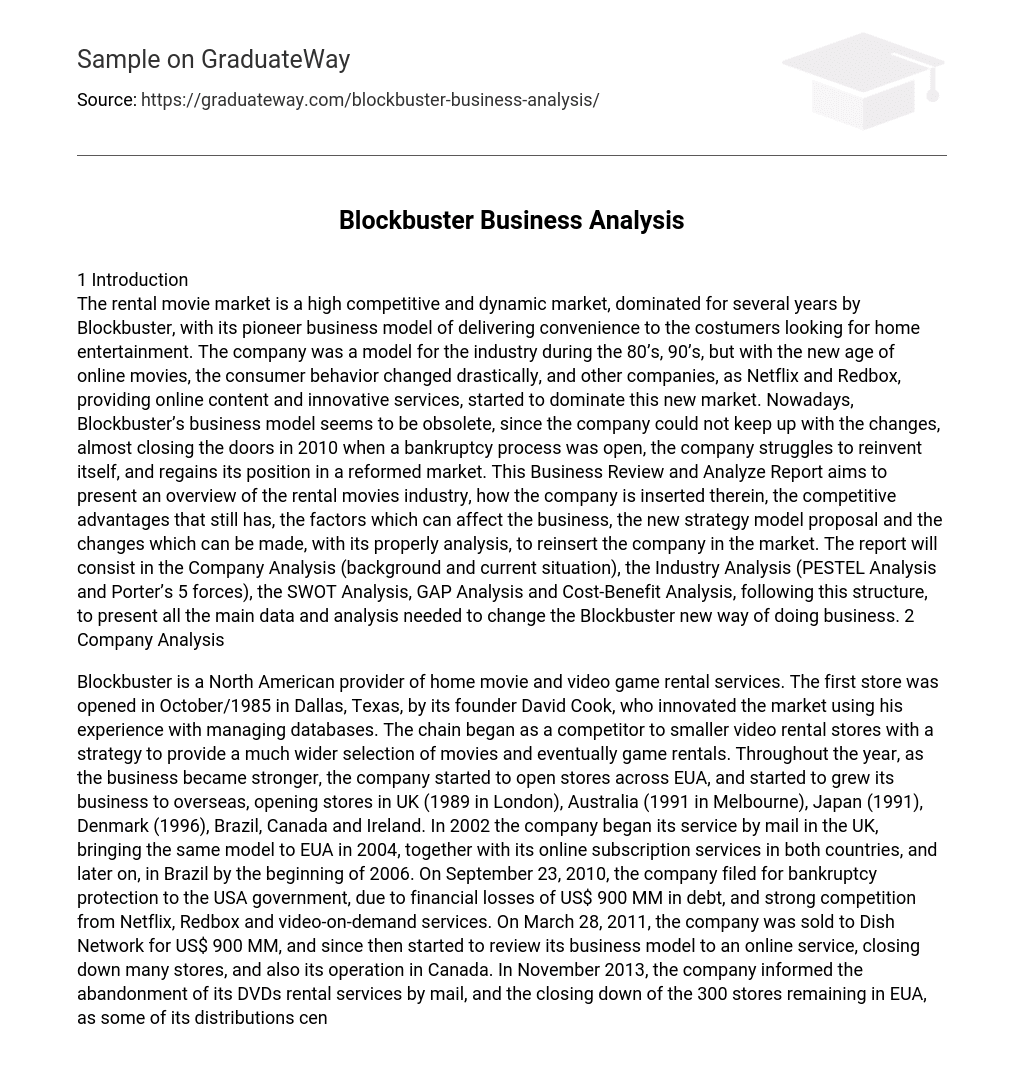Introduction: The rental movie market was once dominated by Blockbuster, but the emergence of online movies led to the rise of other companies like Netflix and Redbox. Blockbuster faced difficulties in adapting and came close to bankruptcy in 2010. This report will provide an overview of the rental movies industry, assess Blockbuster’s current situation, identify its competitive advantages, analyze factors that can impact its business, propose a new strategy model, and suggest necessary changes to reenter the market.
Company Analysis: The company analysis section will encompass background information as well as an evaluation of Blockbuster’s present state.
Blockbuster, an American provider of home movie and video game rental services, was founded by David Cook in October 1985. Cook’s aim was to offer a wider selection of movies and game rentals compared to smaller video rental stores by utilizing his expertise in database management. The company expanded its presence both within the United States and internationally, opening stores in London (1989), Melbourne (1991), Japan (1991), Denmark (1996), Brazil, Canada, and Ireland. In 2002, Blockbuster introduced its mail service in the UK before bringing it to the United States in 2004. Online subscription services were also available in both countries and expanded into Brazil in early 2006.
However, fierce competition from Netflix, Redbox, and video-on-demand services along with significant financial losses totaling $900 million led Blockbuster to file for bankruptcy protection on September 23, 2010. On March 28, 2011 Dish Network acquired Blockbuster for $900 million. Following the acquisition, Blockbuster began shifting towards online services as part of its strategy to reshape the business model. This resulted in numerous store closures including operations in Canada.
In November 2013, Blockbuster made the decision to cease its DVD rental services by mail and close all remaining 300 stores along with certain distribution centers by January 2014 due to changing consumer preferences towards digital rental options.Currently, the company is evaluating potential changes to its business model in various countries.
The chart below is designed to provide a business overview as a complement to the company’s analysis:
3 Industry Analysis
3.1 Macro Environment (PESTEL analysis)
According to Wikipedia, PESTEL (Political, Economic, Social, Technological, Environmental and Legal) Analysis is ”… a part of the external analysis when conducting a strategic analysis or doing market research, and gives an overview of the different macro-environmental factors that the company has to take into consideration. It is a useful tool for understanding market growth or decline, business position, potential and direction for operations”. The following chart will present the PESTEL analysis of the Movie Rental Industry worldwide, along with the main comments below it:
3.2 Analyzing the competitive landscape using Porter’s five forces:
To assess the industry’s competition and attractiveness, we will present Porter’s Five Forces analysis. This analysis examines the bargaining power of suppliers and customers, the threat of substitutes, barriers to entry for new competitors, and the intensity of competitive rivalry.
4 SWOT Analysis / GAP Analysis / Cost-Benefit Analysis
4.1 SWOT Analysis
SWOT analysis is an acronym that represents the internal Strengths and Weaknesses of a company, as well as the external Opportunities and Threats of the market in which the organization operates. It is a commonly used tool by managers to gain a rapid understanding of the strategic situation.
This report will present the SWOT Analysis for Blockbuster:
4.2 GAP Analysis
The GAP analysis involves a framework that describes and identifies the key changes and solutions that the company is seeking to accomplish with the new strategy. The following chart presents the GAP analysis for Blockbuster, considering the requirements for the new online business model:
4.3 Cost-Benefit Analysis
Cost-Benefit Analysis, as defined by Wikipedia, is a methodical procedure for evaluating and contrasting the advantages and disadvantages of a project, decision or policy. Its primary purpose is to validate investments and serve as a foundation for project comparison and analysis. In the case of Blockbuster, the key strategic changes revolve around preparing the company for the emerging online market. The following chart will outline the principal solutions/initiatives in this regard:
5 Conclusion
The report highlights the fierce competition in the online market, currently dominated by major players like Netflix and Redbox. It acknowledges that the online market is the future of the movie rental industry but states that Blockbuster’s outdated business model does not align with current consumer behavior. Purchasing or renting movies through traditional methods is no longer popular among consumers who now seek a fast, universal, and affordable way to watch movies on various devices such as computers, phones, and tablets. Despite this challenge, Blockbuster still has a strong brand that resonates with consumers. By reinventing itself, there is potential for attracting customers towards online movie rentals. To ensure survival, it is crucial for Blockbuster to change its distribution model, restructure its IT infrastructure using an online provider, and revamp its entire strategy based on new consumer behavior. The report provides comprehensive data analysis and information to support this transformation.
6 References
You can find more information about Blockbuster in the following links:
http://www.studymode.com/essays/Blockbuster-Swot-Analysis-739005.html,
http://www.yousigma.com/comparativeanalysis/blockbusterinc.html,
http://laurenmckelvey.wordpress.com/2012/05/01/blockbuster-analysis/,
http://g1.globo.com/economia/negocios/noticia/
2013 / 11 / blockbuster-closing-stores-and-distribution-centers-in-the-us-in-january. html ,
and https: //en.wikipedia.org/wiki/
Blockbuster_LLC .
Below is a list of sources that offer information on the movie rental industry:





